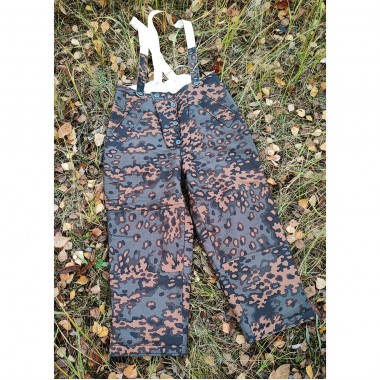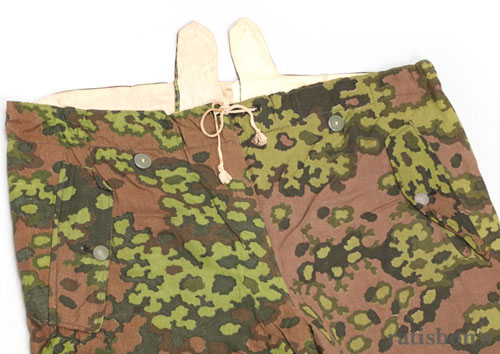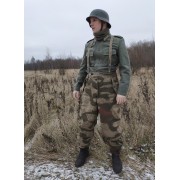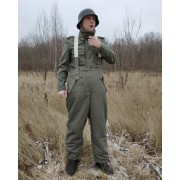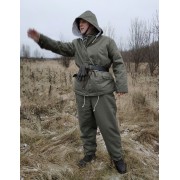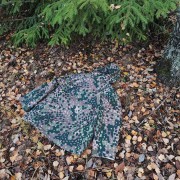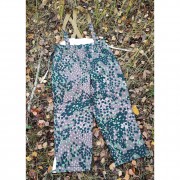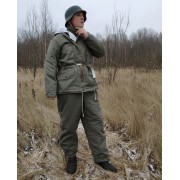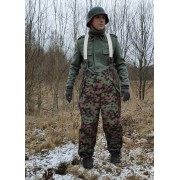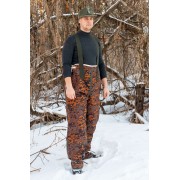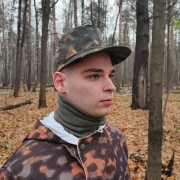How to choose the size?
The price is only for the pants. Suitable jacket is sold separately. See the recommended products at the bottom of the page. Buy pants and jacket at once to get a set. The color and material may change slightly with each new batch, you can't buy a part of the set in addition later, we will not be able to select the matching fabric!
In the product photo: size II (medium) is worn on a person who usually wears Russian size 52 or L, XL. Height 180 cm, chest 100 cm, body circumference under the lower rib 92 cm, belly circumference 98 cm. The key size for the pants is the circumference under the rib! If this body part fits into the pants, then the belly will definitely fit.
The size of the jacket fits the size of the pants, that is, the jacket and pants must be bought in the same size. If you wear a tunic of size M, then you need to buy a winter jacket M (that is, size I), you should not add the size "for the winter", everything has already been added. The standart height for the jackets and pants is 182 cm. This affects the length of the sleeves for jackets and the length of the legs for pants. German winter jackets were of three sizes: small, medium and large; we did the same. German winter jackets are made wide enough not to fetter a soldier and to fit different body-shapes; this must be understood if you are not buying a jacket for reenactment, but for civilian use.
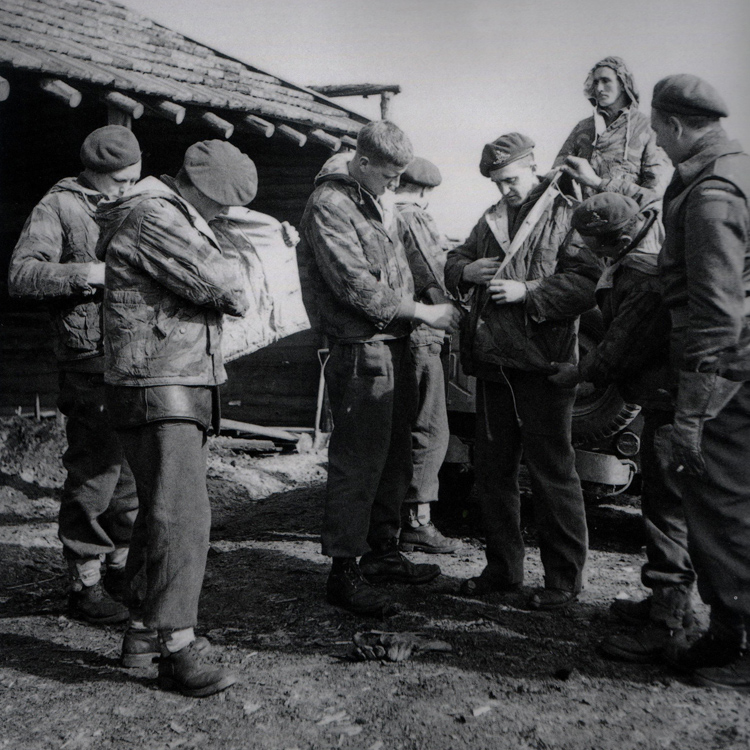
Canadian soldiers in Merksem, Belgium (near Antwerp), seizing the unifroms warehouses of the factory Reitz. The terrain is flat, rugged by rivers, the weather is windy and cold: Canadians are insulated as they can. Pay attention to the ratio of length and width of German winter jackets. Photo source: National Archives of Canada and the book of V. Palinckx "Camouflage uniforms of the German Wehrmacht."
You can choose the size without trying. You will need a flexible meter or at least a rope. Measure a similar winter jacket that suits you. Designations:
• Flat top width — of pants horizontally on the upper cut; this place is located directly under the ribs (not where jeans are worn, because the waist of the German uniform is higher); this is the pants' bottleneck: the waist and hips of the pants will be wider.
• Lenght — along the leg outside seam.
• Depth — from waist to the crutch, along the front. Winter pants are deep, like standard field pants.
• Waist maximum — girth below the rib, but above the navel, where the Germans had a belt); the first measurement over the naked body (in brackets the same but over shirt + sweaters + tunic, as is customary to wear these pants).
All measurements are in centimeters. Devide numbers to 2,54 to have inches.
| Size of the pants | Russian, international size | Flat top width, cm | Lenght, cm | Depth, cm | Waist max., cm |
| I | 48-50, S-M | 48 | 111 | 42 | 90 (96) |
| II | 52-54, L-XL | 52 | 113 | 43 | 98 (104) |
| III | 56-58, 2XL-3XL | 56 | 115 | 44 | 106 (112) |
Вou can choose the size that is in stock. If the required size cannot be selected, then it is (already) out of stock.
Description
The pants are sewn from dense natural fabric with linen weaving (cotton duck, such as a tent). Such fabric protects from wind and water the best. Unfortunately, the fabric is not completely waterproof because it is not synthetic. Original winter sets also got wet (especially towards the end of the war, when there were a lot of viscose in the composition). Below is a video about fabric printed exclusively for our shop in October 2019.
The camouflage pattern is carefully copied: this is the work of of our Replika shop team. The color scheme is taken from the original costume presented in the book L. Silvestri "Waffen-SS camouflage uniforms", volume 2, pages 774-792. The fabric was made exclusively for our Replika shop and used for our winter jackets; it is not sold anywhere except reenact.store. It should be noted that we used 2 different rolls of camouflage, which are slightly different in color and contain different print defects. This is done specifically to repeat the original, which is also assembled from pieces. At the end of the war, the savings were tough, and scraps of fabric from previous runs of clothes used for small parts. Sometimes even large parts were from different lots (for example, front and back jackets or pants).
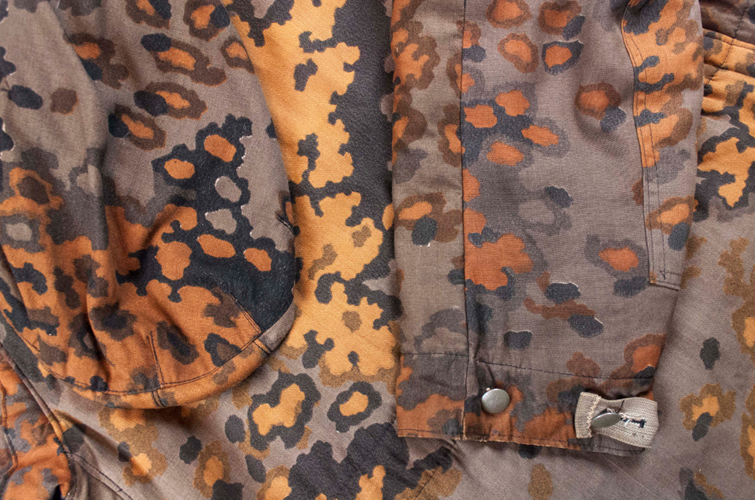
Original winter jacket in Oak camo, made from different shades of the same camouflage.
The same applies to the white side of the pants: it is tailored from pieces of white fabric that are slightly different in color. Inside the insulation from recycled clothing is used, as it was in the originals. The Germans collected the old uniforms, as well as civilian clothes (including trophy and confiscated) and recycled it, getting a cloth like a loose blanket. The composition of such insulation varied due to the heterogeneity of the raw materials. In general, winter suits were not very warm. They had to be worn over a shirt, a cloth uniform and a sweater (a multilayer military uniform system is used to date). In a full suit, it is comfortable down to -15 degrees Celsius, however, this is not enough for guard duty (long inactivity), for this there were a special overcoat and guard boots.
We were attentive to the details, found and copied even insignificant and inconspicuous at first glance.
Button loops have a round end (eyelet) and a perpendicular limiting seam (lock) at the other end. Not expensive copies have loops with a wedge-shaped end, because this is the norm for modern equipment, and the Germans did not use them in the mid-1940s (extremely rarely on clothes 1944-1945).
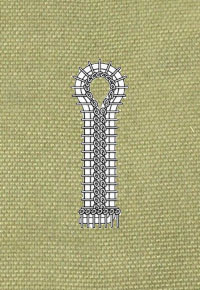 | 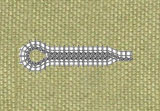 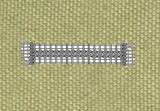 |
On the left is the correct buttonhole shape for German winter suits, with a clip at the end. On the right are 2 variants of non-characteristic loops, which, however, can be found on some copies.
Pants suspenders were usually made from braid of a harsh (off-white) color. The ends with buttoned loops are often reinforced with camouflage or white fabric.
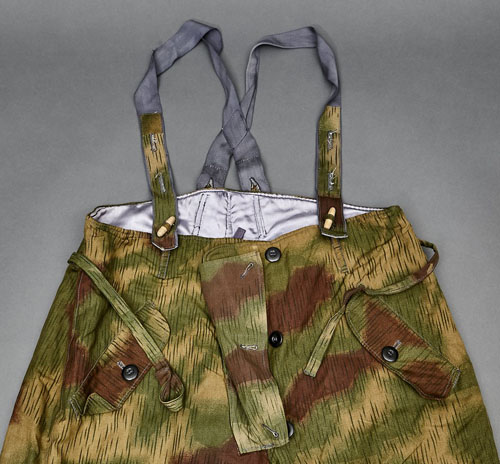
Suspenders of German winter pants in the “Swamp” camouflage are made of gray tape (most often it was a white undyed tape) and with reinforcements of camouflage fabric at the ends.
Winter suits had metal pebbled buttons (standard for the German uniform). However, glass and plastic buttons, flat with 4 holes were often found. This was due to the development of the German chemical industry, which complied with the development of new, cheap and durable materials. Flat buttons were more convenient than metal buttons on a leg, although they didn’t look so beautiful. Sometimes the buttons were made of pressed cardboard, these had a characteristic design with small corrugations in a circle. Buttons for pockets and suspenders often differed from those that stood on the front fastener. Similar original jackets often have a different set of buttons!
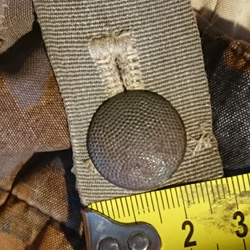
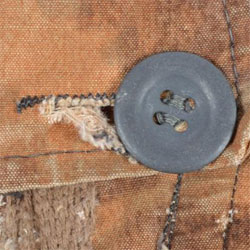
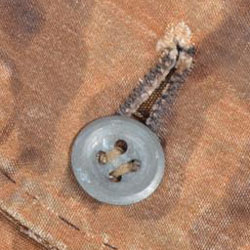
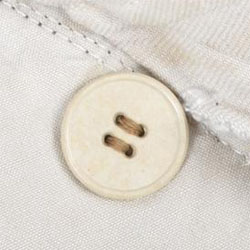
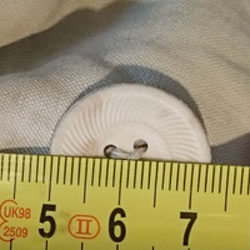
Types of original buttons on SS winter jackets (not a complete list). Original photo source: lux-military-antiques.com, Anton Volchkov and others.
German winter pants have one design flaw: the attachment of suspenders. When you squat fast, the load on the buttons that hold the suspenders on the back is so big that they come off. Only at the very end of the war did the Heer try to solve this problem by fixing suspenders to wooden bosses that were fastened to the pants through a tie (due to the large area of the mount, it withstood heavy loads). The SS tried to solve this issue when creating a camouflage winter uniform. They made straps with buttons for fixing standard elastic suspenders on them, like it's on M43 field trousers. However, this model did not go into series and until the very end of the war the problem remained. Before using pants for the first time, we recommend to stitch the buttons on the back through (one to another). This will strengthen them.
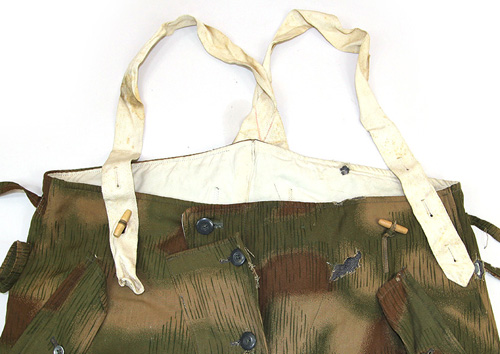
On the left are the origonal pants of the SS "Oak" (experimental cut), where the SS tried to fix the problem with the suspenders. To the right are the original “Swamp” pants of the Heer with a new suspender mount. Photos of original items from the site ratisbons.com and others.
There are reinforcements on the knees of the pants (extra layer of fabric). Typically, these pieces were cut across (not along the fabric), and the camouflage pattern there always goes horizontally. The front closure has a wind-flap without insulation. These features appeared together with camouflage models of pants (they are rarely found on plain colour, mouse-gray ones). These features appeared no earlier than the winter of 1943/44. Moreover, these features of tailoring are not boundedd to the color of the jacket, but to the time of its manufacture. For example, the original winter suits in camouflage Oak Spring (green shades of spots) were sewn both to the early and late patterns.
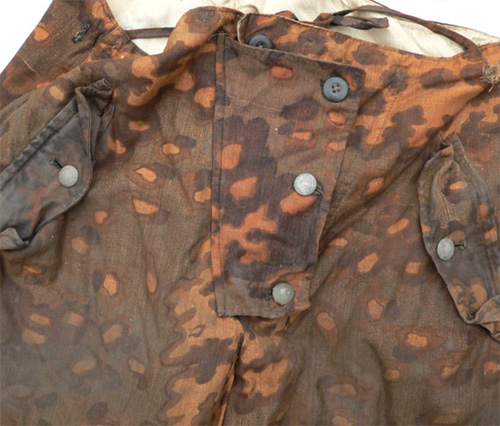
Wind-flap on the original winter pants SS "Oak-B". Photo of the original item militariaplaza.nl
The pockets of SS winter jackets were 5-point (unlike the 4-point in the Heer), but the pockets on the trousers were always the same (4-point, straight).
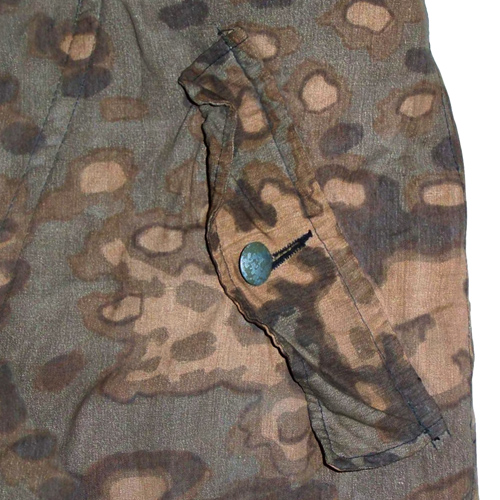
Pocket valve on the original pants in camouflage "Oak-B". Photo of the original item from the forum warrelics.eu
How to care for the product?
The soldiers at the front did not have the opportunity to wash their jackets (especially in the washing machine). After the winter (or in the case of taking the unit to rest in the deep rear), they handed the winter uniform over, and the rear services cleaned, sorted and stored it. Therefore, washing the winter uniform in the washing machine is an extreme measure. To get started, you just need to wash the jacket with a sponge or a soft brush with soap or detergent for natural fabrics in those places where it is dirty (usually this is the neck and cuffs). You can wash off the detergent with a jet of water (shower in the bathroom, for example).
The use of bleach (stain remover) is permissible only manually on the white side and on a dry jacket. So you can return the whiteness to the cuffs and other dirty areas. However, if bleach seeps onto the camouflage side (for example, through a seam), white spots will forever remain. It is unacceptable to wash the entire jacket in bleach!
Washing a jacket is the removal of contaminants from external surfaces; inside the jacket there is nothing to wash. If you decide to save time and wash in a machine, then select the delicate washing mode at a temperature of no higher than 40 degrees. The jacket will not deteriorate, the color will not fade, however, the jacket will slightly lose its shape and will no longer look like new.










